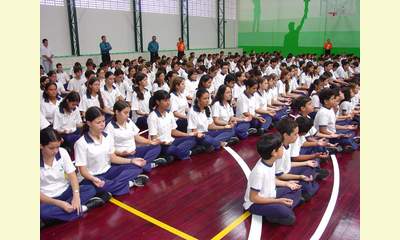|
|
Activities of Living Values in Education Program in Brazil
un article par Diane Tillman
VIVE Brazil continues with its activities in Brazil
with the support of Brahma Kumaris, the Living
Values Institute and other institutional partners .

Living Values Education relax exercise
click on photo to enlarge
In 2011, VIVE was active in the capital city of
São Paulo and other cities such as Vinhedo,
Valinhos, Piracicaba, Itatiba, Amparo, Itapecerica
da Serra and Piquete, with training courses and
other activities. In addition to Sao Paulo,
other parts of the country were involved: in Minas
Gerais; the cities of Belo Horizonte and Três
Corações; and in Mato Grosso, the town of
Primavera do Leste. In the state of São Paulo
educators were trained from 16 state and municipal
schools, with a total of 368 educators. Other
events promoted in 2011 included Workshops, the
Junina Festival, Bullying, Active Listening and
the "Spring of values." The latter was organized
in partnership with other organizations in
Ibirapuera Park. Those who attended had the
opportunity to make and to admire a Flag of Peace
of 10 square meters ( see video at:
http://www.youtube.com/watch?v=m0kwkka2DNE ) .
College PH3 in Parnamirim (state of Rio Grande do
Norte) inserted into its pedagogical proposal a
program for staff, faculty and students and the
wider community with the implementation of
activities , training courses and seminars by
VIVE. For students relaxation and visualization
are often used at the beginning of eah class,
beginning with views of positive and motivating
images. The practice aims to mental and physical
relaxation that will have benefits for the start
of pedagogical activities. Teachers and parents,
according to Director Frances Henry, concluded
that as a result students showed more enthusiasm,
calm, concentration, creativity and the
development of positive behaviors .
In College Raimundo Nonato Vieira in Marazion,
state of Ceará, educators of early childhood
education conducted activities for values by means
of visualization techniques. The exercises take
place in the courtyard and classroom for the
discipline of Human Formation. Activities have
produced benefits such as more harmony in the
classroom, more peaceful children, child's ability
to distinguish correct from wrong attitudes,
conflict resolution and better communication
between students and teachers and students and
parents.
Also in the state of Ceará , VIVE took part in two
seminars on Culture of Peace , Ethics and
Spirituality, organized by the Federal University
of Ceará. The seminars involved composing and
conducting roundtable workshops and publishing
articles in the past three volume book of the same
name. Training for educational coordinators from
five schools of Municipal Education Managers and
seven state schools in seven cities in the state
took place in partnership with the Department of
Education of the State of Ceará, as well as
lectures and workshops for other institutions.
(Click here for a Portuguese version of this article)
|








|
DISCUSSION
Question(s) liée(s) à cet article:
What is the best way to teach peace to children?,
* * * * *
Commentaire le plus récent:
Maria Montessori believed that peace was innate within children. Her timeless educational philosophy was developed around this basic understanding. Perhaps all we need to do as teachers is to provide stimulating learning environments that validate this knowing and understanding and nurture it. We may not have to actually teach it, Sharing peace-building stories gently attends to this. Strong, creative and imaginative peace-building characters who focus upon win-win and have faith in peace being possible are at the centre of the story plots. In Hassaun Ali-Jones Bey's (Boundless Gratitude http://boundlessgratitude.com/products.html ) unique and mesmerising story, Black Ink is such a character who bravely crosses the universe seeking validation of what he knows in his heart. The magical character also models all the important peace-building values, understandings and actions needed for peace-building. I believe also that peace-building must be modelled and the whole teaching-learning environment should reflect similar values, understandings and actions...as is the primary focus of the Save the Children Australia UN Global Peace School Program upon which I am presently fortunate to be working. . ... continuation.

|
|









